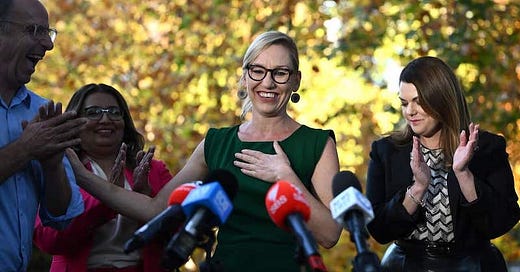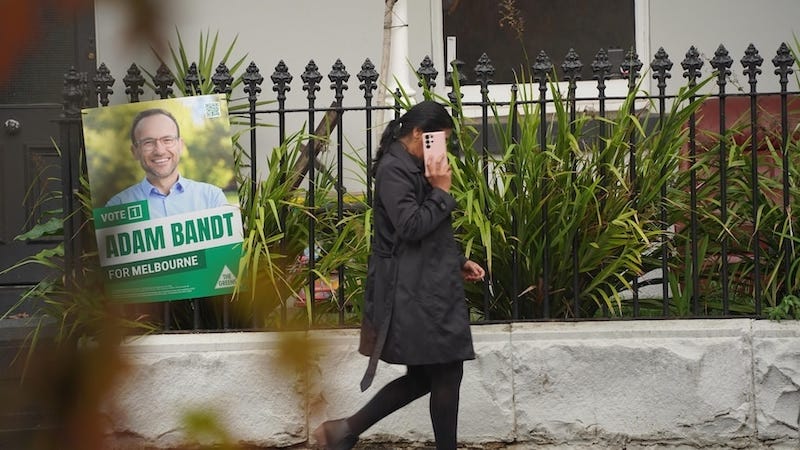A new direction for the Australian Greens
The Greens need to recover trust in their core electorates, and re-engage with the youth constituencies they once assumed would always vote for them.
Senator Larissa Waters is the new federal leader of the Australian Greens, taking over from Adam Bandt who lost his seat following a poor federal election result for the party. The leadership ballot came after Bandt’s surprise defeat in his inner-Melbourne seat – one of three lower house losses that reshaped the Greens’ parliamentary numbers. Waters, a Queensland Senator – in office since 2010, except for a one-year gap in 2017–18 when she was forced to resign over dual citizenship issues – secured the leadership over fellow Senators Mehreen Faruqi and Sarah Hanson-Young. Faruqi was elected the deputy leader, while Hanson-Young will take on the role of manager of business in the Senate.
The Greens enter this new leadership phase under the cloud of a disappointing results in the lower house. They held four seats prior to the 2025 federal election, but now have just a single representative after suffering primary vote swings of between 1-to-4 per cent, including the loss of Bandt’s own seat of Melbourne. Some of this electoral damage may be traced back to the party’s hardline stance on housing policy during the previous term – where, despite extracting significant policy concessions from Labor, the Greens were broadly perceived as obstructionist. The resulting political blowback suggests that strategic success in policy terms doesn’t always translate to electoral gain and the Greens – if they do regain more representation in the lower house in future elections – will have to be more strategic in the way they attempt to achieve their agendas.
In brighter news, the Senate results tell a different story: all incumbent Greens senators were returned, their Senate vote dropped marginally in the face of a broader surge to Labor, and they now hold the full balance of power in the upper house. This places them in a strong position: the government will need their co-operation to pass key legislation, bypassing the need to court minor party or independent support elsewhere.
This contradiction – a loss of seats in the lower house but consolidation in the Senate – shows the mixed signals from the electorate the Greens need to read very carefully. They remain a parliamentary force, but the assumption that younger voters, particularly from Gen Z and Millennials, would naturally gravitate toward the Greens has been disrupted. To survive and grow, the party must reassess not only its electoral strategies but also how it uses power – especially in the Senate, where effective use of influence could define the party’s relevance in this new political landscape.
The art of compromise without giving too much away
The loss of Bandt’s seat in Melbourne was more than just a symbolic blow – it was a reminder of the unforgiving nature of electoral politics. A leader losing their own seat is a rare outcome – although in this election, it was also an outcome that was suffered by the leader of the Liberal Party, Peter Dutton – and while the Greens might find some comfort in a stable Senate vote in the upper house, the broader result suggests a deep analysis and re-assessment of the direction of the party. The idea that a steady or even rising primary vote can offset the loss of three-quarters of their lower house representation doesn’t hold much merit: in politics, it’s all about the number of seats that are won. For the Greens to remain a serious political force across both chambers of Parliament, this result cannot be rationalised away as a statistical anomaly: it requires recalibration and a more sophisticated political strategy.
The Greens can’t afford to ignore what mainstream parties such as Labor and the Liberals have long understood: elections are won by converting votes into seats, not by holding onto ideals while losing political ground – the primary vote means little when it fails to deliver results where it really matters: seats. This is the uncomfortable lesson facing the Greens after going from four lower house MPs to just one. And while policy positions on housing and climate might resonate with parts of the electorate, when those positions translate into prolonged legislative blockages – as they did twice during the last term – it carries a significant cost. Delaying key reforms by months and up to a year, even if done in the name of better outcomes, ends up looking like obstructionism when measured in the court of public opinion. That was the political price paid by the Greens in this election.
Max Chandler-Mather, often described as a leading figure in the party’s combative parliamentary strategy, became the lightning rod for this approach. While criticism focused on his tone and tactics, his personal primary vote didn’t collapse – he was only 3 per cent behind his Labor opponent – he simply couldn’t secure the right preference flows in the seat of Griffith, and lost the seat with a significant two-party preferred swing of 21 per cent. Again, achieving a high primary vote isn’t relevant if the seat ends up being lost on preferences.
This was true for Bandt as well. In both cases, the Greens were caught in a preference pincer: unable to attract sufficient support from either side of the political divide, and this issue raises a larger structural problem. In an era of major party polarisation, Greens candidates are especially vulnerable to big swings, whether they are to the LNP or to Labor. The Queensland state election in 2024 had already served up an early warning signal of this phenomenon, and the federal result confirmed it: when large swings favour the two major parties, the Greens suffer, even if their overall vote holds.
There’s now an greater need for the Greens to navigate this situation in a better way. That doesn’t mean abandoning principle, but it does mean understanding the art of political compromise – what’s worth pursuing, what needs be conceded, and how to package trade-offs in a way that speaks to both their base and the broader electorate. The perception of being uncompromising – even when paired with real policy gains – can backfire. The Greens must now develop the ability to compromise without appearing to cave in which, essentially, is the true art of politics. That means being able to pass legislation, not because they agree with every clause, but because of exchanges in other pieces of legislation, they are able to deliver on vital environmental safeguards, or secure other social justice outcomes.
There’s also a more technical lesson in all this. The Greens need to better understand preference flows. In a fragmented electoral landscape – in the lower house, 33 per cent of the electorate voted for independents and minor parties. With the collapse of the Liberal vote in key inner-city areas, Greens candidates were squeezed out. The Greens may need to design smarter preference strategies, because without a plan for navigating future swings, even strong first-preference numbers won’t be enough to reclaim ground in the lower house.
The pathway back to relevance in House of Representatives won’t be easy, especially if the Liberal Party continues to underperform in metropolitan seats. The Greens’ success in inner-city Melbourne and Brisbane was built on triangulating preferences between Labor and Liberals and it appears that if one leg of that triangle disappears, the whole structure becomes unstable. And unless they can adapt, the Greens risk becoming a party of upper house influence only – and that is still a favourable and powerful outcome – but they’d be locked out of the more visible and electorally defining contests of the lower house.
Strategy, a Greens identity and the youth vote
With new leadership under Senator Waters, the Greens now face a defining moment: whether to double down on their principled identity or pursue a more pragmatic, strategic role in Parliament. The challenge isn’t just one of rebuilding electoral strength – it’s about clarifying their purpose, adapting to a changing voter base, and deciding what kind of political force the Greens want to be: it’s not a reconstruction, but it does need a renovation.
Central to this crossroads is a growing uncertainty about the Greens’ claim to the youth vote. The loss of Melbourne, Brisbane and Griffith – three of Australia’s most youth-dense electorates – was not only unexpected but symbolically devastating. These seats were long viewed as strongholds for the party’s future, home to a high proportion of Gen Z voters, renters, progressive professionals, and politically engaged younger citizens. In the seat of Melbourne, the Greens led strongly on the primary vote, yet failed to hold the seat because they failed to navigate preference deals correctly. In Brisbane and Griffith, they were simply outpolled by both Labor and the Coalition.
What do these defeats say about the Greens’ connection to younger voters? The data offers a complex, and at times counterintuitive, picture. While high levels of youth engagement once translated directly into strong Greens support, this relationship is no longer guaranteed – in any case, just like any other demographic, there is no clear picture of what the ‘youth vote’ looks like. Younger voters are not a monolithic bloc. In seats such as Wills in Melbourne, the Greens’ primary vote remained strong, suggesting enduring support among younger progressives.
However, the socio-economic profile of these seats is shifting. Many of the so-called “youth electorates” now have rising income levels, a large presence of professionalised public servants, and housing markets that are pricing out their younger residents. These conditions are increasingly linked to political volatility – and in some cases, a surprising shift toward the major parties. In higher-income pockets, a small but notable swing toward the Liberal Party suggests that the Greens’ anti-corporate, redistributionist messages may not always land as intended. Meanwhile, renters and under-40s – once assumed to be a bedrock of Greens support – showed more mixed voting behaviour, particularly in tightly contested seats. Again, just like any other demographic, renters and under-40s don’t all vote in the same way.
What also emerges is a generational split in how younger Australians approach politics. Millennials – who are now in their 30s and 40s – appear to be settling into more traditional voting patterns. They lean progressive, favour Labor over the Coalition, and are less likely to embrace political outsiders. Gen Z, by contrast, shows signs of becoming a more unpredictable political force: campaign-sensitive, issue-focused, and less attached to party loyalties. Their support is not guaranteed by any party – it’s a support that must be won and then won again in each election cycle.
This shift has profound implications for the Greens’ political strategy. The party has long relied on an appeal to youth values of climate action, equity, social justice – even though these issues affect everyone – as a foundation of its identity. But the assumption that these values automatically translate into votes is now under pressure. The question is whether the Greens can evolve to meet this emerging electorate where it is: not by diluting their message, but by refining how they deliver it, and how they translate principle into tangible policy wins.
This evolution might require a more disciplined and politically mature approach – particularly in how the party balances idealism with the responsibilities of influence. In a Parliament where they hold the balance of power in the Senate, the Greens can’t afford to be perceived as being perpetually oppositional or incapable of compromise. Gen Z voters, like all voters, expect results. If the party represents delay, deadlock or political posturing, that generational goodwill will continue to erode.
The coming parliamentary term will be a test of when the Greens can adapt – whether they can turn their Senate power into legislative achievement, recover trust in their core electorates, and re-engage with the youth constituencies they once assumed would always vote for them. That assumption can’t be made anymore; the political map has shifted. The Greens must now learn to campaign and govern according to this fundamental realignment.











